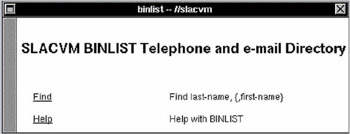Origins of the Web
| < Day Day Up > |
The World Wide Web was created in 1990 by Tim Berners-Lee to allow particle physicists to share information with each other over the Internet more easily. Before then, people shared information on the Internet using various programs and protocols: email, FTP, Gopher, and others. The Web standardized and unified data formats and file-transfer protocols, greatly simplifying the sharing of computer files. It defined HTML as the primary format for documents. Naturally, the first websites were created and hosted where Mr. Berners-Lee worked: the Centre European Research Nuclear (CERN) particle-accelerator facility in Geneva, Switzerland.
To access the Web, a Web browser is required. Tim Berners-Lee wrote the first browser and released it to the physics research community when he announced the World Wide Web. This first browser worked only on the NeXT computer. [1] Like today's browsers, it displayed "rich" text ”bold, italics, fonts ”formatted in HTML, and it displayed links as clickable underlined text. However, it displayed only text. Images, type-in fields, and other controls, if required by a website, had to be displayed in separate windows , using specialized browser plug-ins and protocols.
Because many early Web users did not have NeXT computers, other browsers were soon written. For example, many physicists in the early 1990s used a text-only "line-mode" browser that ran on most Unix computers. This "line-mode" browser was not at all graphical: It displayed only plain text and showed links as bracketed numbers next to the linked text (e.g., "black hole [2]"). To follow a link, you typed its number, as in many character-based library catalog systems.
The first U.S. website was put up in 1991 by Paul Kunz at the Stanford Linear Accelerator in northern California (Figure I.4). The main information available on the Web in those early days was physics experiment data, an index of physics papers, and address directories of physicists.

Figure I.4: slacvm.slac.stanford.edu (Dec. 1991)-Home page of first U.S. website, viewed through the NeXT Web browser, which displayed only text. Links to two databases ” a directory of Stanford Linear Accelerator employees and an archive of high-energy physics preprint papers. (To see this page and more of the first U.S. website, visit www.slac.stanford.edu .)
After 3 years of obscurity, the Web took off in 1994, when the National Center for Supercomputing Applications (NCSA) at the University of Illinois released Mosaic. Developed mainly by students, Mosaic was a graphical "point-and-click" Web browser, available for free. Unlike the NeXT browser, Mosaic could display images. Immediately, people in technical professions began creating websites, for both work and pleasure . They were soon followed by a few pioneering online businesses. The Web began growing exponentially: 100 sites; 1000; 10,000; 100,000; 1,000,000; and so on. By the late 1990s, the number of websites was growing so rapidly that most attempts to plot it went essentially straight up.
[1] NeXT computers were sold from the late 1980s through the mid-1990s.
| < Day Day Up > |
EAN: 2147483647
Pages: 128